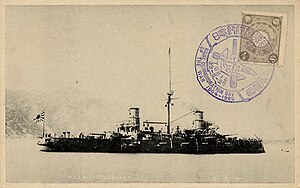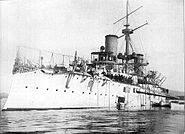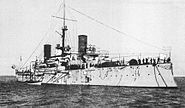| Giuseppe Garibaldi-class cruiser | |
|---|---|
 Kasuga in 1900 | |
| Class overview | |
| Builders: |
Ansaldo, Genoa, Italy Orlando, Livorno |
| Operators: |
|
| Built: | 1895–1904 |
| In commission: | 1896–1954 |
| Completed: | 10 |
| Lost: | 3 |
| General characteristics | |
| Type: | Armored cruiser |
| Displacement: |
7,628 long tons (7,750 t) Kasuga 7,698 long tons (7,822 t) Nisshin |
| Length: |
108.8 m (356 ft 11 in) w/l 111.73 m (366 ft 7 in) o/a |
| Beam: | 18.9 m (62 ft 0 in) |
| Draught: | 7.32 m (24 ft 0 in) |
| Propulsion: |
2 shaft Reciprocating Vertical Triple Expansion (VTE) Engines 8 boilers 13,500 shp (10,100 kW) |
| Speed: | 20 knots (23 mph; 37 km/h) |
| Range: | 7,000 nmi (13,000 km) at 10 kn (12 mph; 19 km/h) |
| Complement: | 600 |
| Armament: |
2 turrets, each with |
| Armour: |
Main Belt: 70–150 mm (2.8–5.9 in) Deck: 25–38 mm (0.98–1.50 in) Barbette, Turret, Casemate & Conning tower: 100–150 mm (3.9–5.9 in) |
The Giuseppe Garibaldi class were a group of armoured cruisers built in Italy at the end of the nineteenth century. Ten ships were built for both the Regia Marina and for export.
Design and history[]

The design was a private venture by the Italian firm of Gio. Ansaldo & C., which was hoping to profit from the need for the world's navies to modernize towards heavily armoured steam warships. Designed by Edoardo Masdea, the Garibaldi-class cruiser was a hybrid between a cruiser and a battleship. With a maximum speed of 20 knots (37 km/h) the design was slightly slower than contemporary cruisers, but was both heavily armed and armoured, in a package with very low displacement and moderate dimensions.
The design was so popular that between 1894 and 1902 ten cruisers were purchased by four different countries; the first five by the Italian Navy, four by the Argentine Navy and one by the Spanish Navy. According to Brassey's Naval Annual, Spain was planning to acquire a second "Garibaldi"-class cruiser, to be named Pedro de Aragon. These plans were shelved after the Spanish-American War and the subsequent downsizing of the Spanish Armada.
Two of the Italian ships ordered in 1902 were sold to the Argentine Navy before completion as the Mitre and Roca; they were renamed as the Rivadavia and the Mariano Moreno. The Argentines in turn sold them to the Imperial Japanese Navy before final completion in 1904, and they were renamed the Kasuga and Nisshin
The class was unusual in that they did not have a uniform main armament. Some had single 10-inch (254 mm) guns in gun turrets fore and aft; others (including the Kasuga) had a mixed armament of a single 10-inch (254 mm) gun in one turret and another turret with twin 8-inch (203 mm) guns. A third variation (including the Nisshin) was a uniform armament of four 8-inch (203 mm) guns, twin gun turrets fore and aft. The Cristobal Colon was fitted with defective 10 inch guns which were removed before it was committed to combat. Therefore, it only went to battle with 10 smokeless powder Armstrong six inch guns mounted in the hull (5 on each side).
Ships[]
All ships were built by Ansaldo in Genoa, except ARA San Martin and ARA Belgrano which were subcontracted to Orlando of Livorno
| Navy | Ship | Launched | Fate |
|---|---|---|---|
| Argentina | Garibaldi | 27 May 1895 | Decommissioned 20 March 1934 |
| Argentina | General Belgrano | 1896 | Decommissioned 8 May 1947 |
| Argentina | Pueyrredón | 25 July 1898 | Decommissioned 2 August 1954 |
| Argentina | San Martín | 1896 | Decommissioned 18 December 1935 |
| Italy | Francesco Ferruccio | 23 April 1902 | Decommissioned 1 April 1930 |
| Italy | Giuseppe Garibaldi | 29 June 1899 | Sunk 18 July 1915 by Austro-Hungarian submarine SM U-4 |
| Italy | Varese | 6 August 1899 | Decommissioned 4 January 1923 |
| Japan | Kasuga | 22 October 1902 | Disarmed 1920s, sunk by bombing 18 July 1945 |
| Japan | Nishin | 9 February 1903 | Disarmed 1920s, scuttled 1936
Later raised and expended as a target ship, sunk by Yamato on 18 January 1942 |
| Spain | Cristobal Colon | September 1896 | Scuttled by the crew 3 July 1898 after being run aground and surrendering during the Battle of Santiago de Cuba the US Navy tried to save the ship but it
slid off the beach and capsized |
| Spain | Pedro de Aragon | N/A | Cancelled, never built |
See also[]
| Wikimedia Commons has media related to Giuseppe Garibaldi class cruiser. |
References[]
- Fraccaroli, Aldo (1970). Italian Warships of World War I. London: Ian Allan. ISBN 978-0-7110-0105-3.
- Cowan, Mark and Sumrall, Alan "Old Hoodoo" The Battleship Texas, America's First Battleship (1895-1911) 2011
External links[]
- (Spanish) History of the Argentinian ships, at HISTARMAR
- (Spanish) Specifications of the Argentinian ships, at HISTARMAR
Gallery[]
| |||||||||||||||||||||||
| |||||||||||||||||||||||||||||
The original article can be found at Giuseppe Garibaldi-class cruiser and the edit history here.




